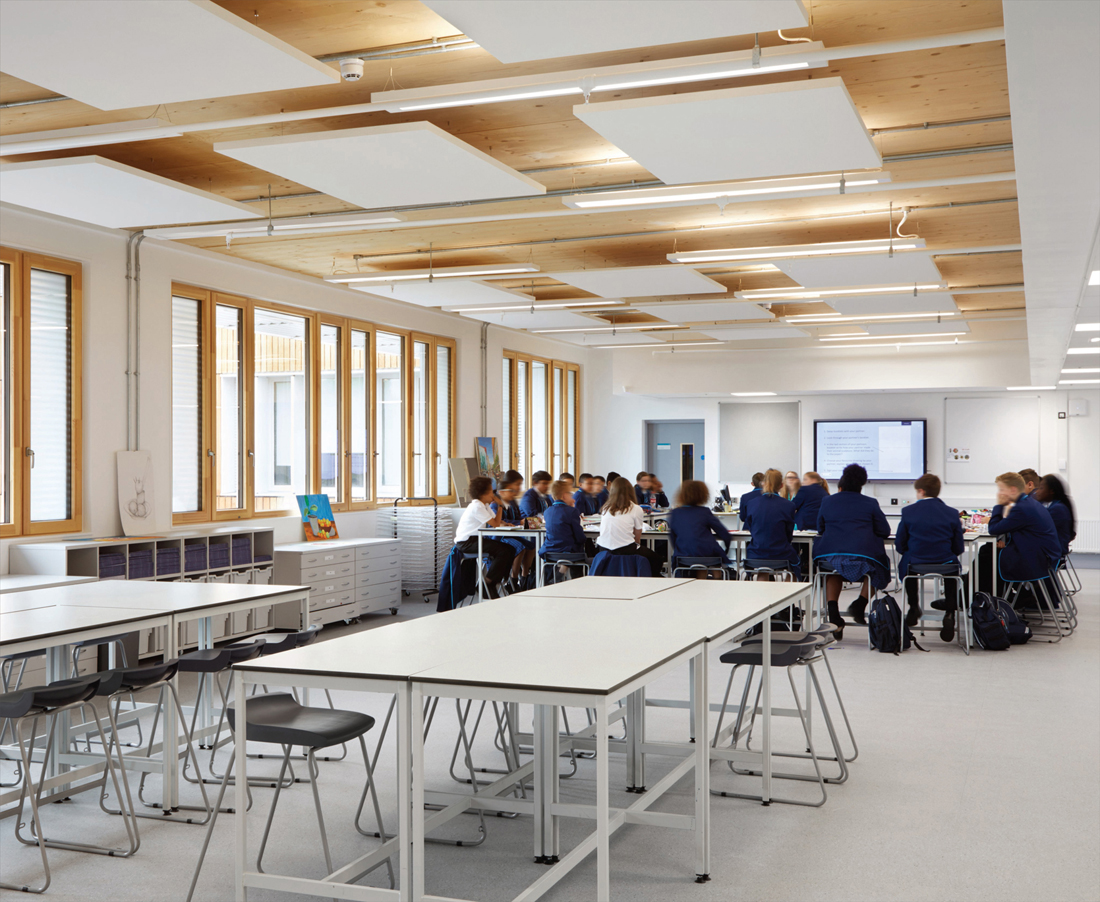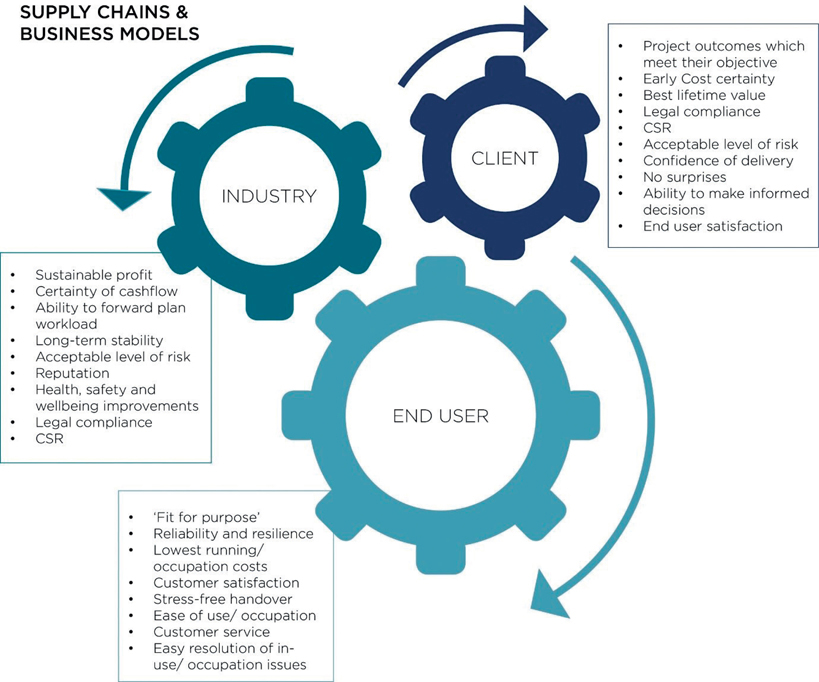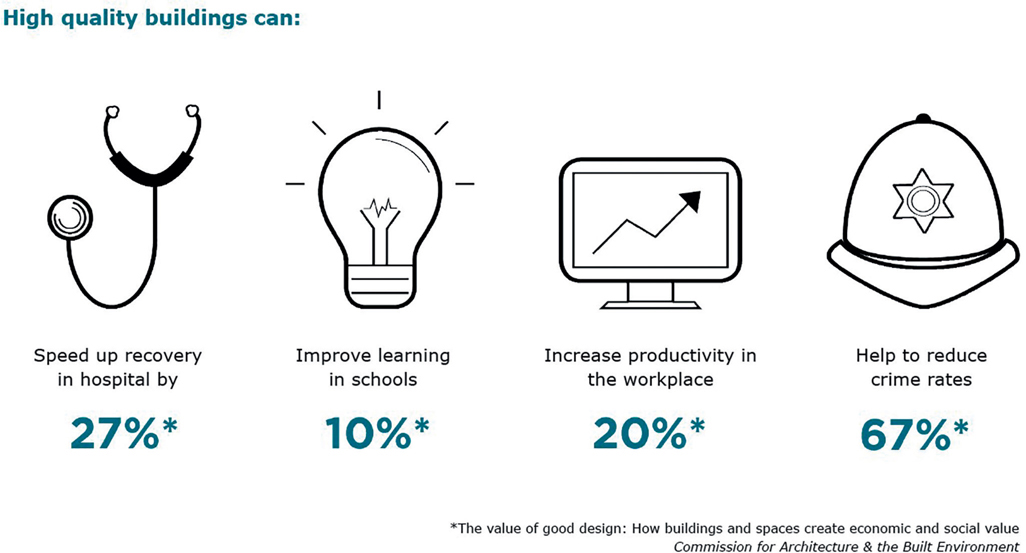FIG 6.0 (chapter opener) Flexible teaching spaces are formed by extra long span CLT floors to Harris Academy, Sutton, by Architype (2019). We cannot discuss cost and value without defining the terms. In this chapter we will talk about cost, not price, as these are totally different. Cost is generally defined as the amount of resource or opportunity (money) required to create something or deliver a service. There is then the value (and capital cost) at inception, whole life value throughout the life of the building and more recently, social value is considered increasingly important. CLT can create a less harsh environment within a building and wood is more aesthetically pleasing than other construction forms and it can be argued that the value to and wellbeing of a person in using the building is improved. It can be said that the value of something is subjective, but with assessment and benchmarking, increased objectivity can be created with less room for challenge. People are understanding more about the environmental impact of construction and carbon value benefits. Other structural materials are increasingly being recycled and reused, but once they are extracted from the ground in their raw forms, they are gone for ever whereas trees are renewable and therefore more sustainable. CLT can be used to form a whole building structural solution (external walls, floors, internal walls, roof) with a single point of responsibility for design, supply and installation. Designers have the flexibility to use CLT for only one element, say internal walls, if required, whether purely structural or to create a finished surface. FIG 6.3 Unaligned objectives.1 The current procurement model with many differing facets of project interfaces and stakeholders offers little incentive to align interests, leading to the repetition of errors, failure to innovate or adopt best practice and the delivery of inferior products. Whatever the approach, delivering the best procurement strategy in any project is critical to overall success, realising the right cost and value balance and not just simply transferring the risk. The typical project has the usual design team members with advice sought as required from further down the supply chain. Let’s instead capture the expertise and value from the CLT providers by inviting them to be part of the design team and work as an integrated team to deliver an efficient solution from the outset.1 Bringing on board the provider or specialist contractor early allows some of the differing facets of project interfaces to be managed efficiently with the expertise of the supplier. This will ensure all parties are moving in the same direction to the ultimate benefit and increasing the value in the successful project delivery. Cost certainty can be improved earlier on projects if collaboration and involvement of the CLT provider is adopted. The project cost manager will benefit from improved accuracy in estimating resulting in fewer challenges later in the procurement cycle when formal tenders are obtained. The future environmental agenda will impact on planning with the process possibly affecting programme and costs of projects. We cannot just focus on capital cost – whole life cost considerations have far more impact than the initial capital outlay. Mark Farmer in his report on construction ‘Modernise or Die’ stated the cost plan has to move away from the capex fixation if the end pre-manufactured value to the client is improved.2 One issue that does require addressing is where we obtain benchmark cost data for CLT use. Where do we acquire estimated rates for budget cost planning? Could this be hindering the increase in CLT use? It is an emerging method of construction with limited market expertise. The costs and risks, benefits and opportunities, may therefore not be fully understood compared to more established forms. Rider Levett Bucknall (RLB) is addressing this with their suite of Timber Estimating Guides: Timber Frame, SIPS and CLT. This will hopefully break down the perceived barriers and answer more of the important cost questions.3 Producing the CLT structural solution combines the close integration of design and manufacturer from one organisation in a controlled factory environment allowing efficiencies to prevail. The supplier is able to design and get the best possible value out of the product and factory conditions ensure a degree of certainty can happen – getting it right first time, eliminating errors, reworking and waste. Services integration is possible into a CLT panel removing the ‘messy’ on-site builders’ works stages. This is a cost-effective solution, undertaken at design stage and in the factory, for later programme savings. It requires a coordinated design upfront, in the main, but it does not preclude adjustments later. Future-proofing to increase value may be possible by routing for ducts and conduits into panels. Creating anything within a controlled environment will reduce waste. The off-site manufactured solution of CLT minimises waste in the factory as timber is cut precisely to the sizes required for the panel creation. When panels are delivered to site they are, in most cases, offloaded, placed and fixed into position in one go. There is no further cutting and sourcing of other materials to assist in the erection process – it is one complete package that comes from the factory. CLT is available in three different grades. Non-visual grade is generally hidden behind other more traditional treatments and finishes (although it can be left exposed internally). Industrial and domestic visual is a finished product that may have a sealant or stain protection pre-applied. This results in a finished product as soon as it is installed with appropriate protection being required for remaining site works. CLT can be a cost-effective structural solution with improved value being achieved through not having to apply further finishes or treatments. If this exposed finish is not required, it can easily be painted, fully or partially covered to change the look and feel of the environment in which it is situated (as outlined in Chapter 5, Visual aspects). In essence, yes. The overall speed of erection is one factor but there are others. The lightness of the frame can have an impact on the chosen foundation making it simpler to design and construct. Owing to the ‘smaller’ foundation solution there will be fewer transport movements for deliveries of concrete and excavated waste removal. The frame itself is erected from the delivery vehicle meaning no storage on site required and it is placed in position straight away with no double handling. One thing to bear in mind due to the erection speed, it is advantageous for the CLT contractor to have their own crane or dedicated use of the site crane during installation. For the true benefit, the installation cannot be delayed by others using the crane. Informing and educating follow-on trades in the use of CLT will help them better plan and deliver their elements, realising programme efficiencies as far as possible. They could commence their works earlier as once erected the CLT is complete: walls, floor and roof. Depending on the project requirements the CLT, internally, could be the finished product negating the need for the follow-on works – protection is vital. It is far easier for the follow-on trades to screw into timber for a fixing rather than into masonry or concrete, and it is less messy. The programme value is achieving the building earlier. Lower finance costs and a quicker return on investment – these being crucial for most clients. For some clients the programme is priority, for example, in the education sector where the facilities must be ready for the new term. Quality is essential for others with wood generating a warmth and a wellbeing value. Construction can be dangerous with very many separate individual trades used to create the building. CLT can have, and is having, a major impact on minimising construction health and safety risks with the panels created in carefully controlled factory conditions and lifted into position as required by mechanical means utilising pre-installed lifting points. Once secured, the next panel in the erection sequence is placed and so on. Panels may be up to 50m2 in area so in a very short space of time the shell of the building can be erected. This means that fewer people are on site, construction time is reduced overall and the panels can create a ‘finished product’, reducing the need for follow-on trades and subsequent snagging visits. Overall construction risk is reduced as fewer interfaces are required to other trades as the product is created off-site with mechanised erection. A typical internal wall for a project is made up of structure, plasterboard and plaster, decoration and services – with CLT that may be cut down to the material itself plus services. The number of trades or procurement packages, to finish a wall, are reduced by two or three. The present day ‘green credentials’ of building with CLT far exceed any other structural materials. In the future will more emphasis be placed on the green status or energy criteria of a building? Energy Performance Certificates (EPCs) are mandatory in public buildings today, but will the future be more focused on whole life values of the buildings we use and live in? How do we recycle our buildings? All materials can be recycled to some extent, but once the more traditional ones are mined, they are gone forever. CLT remains stable over its life and therefore can be demounted and used again. The panels can therefore be recycled whilst retaining maximum value at the end of their life on site. Building owners and occupiers are ever more focused on the value the buildings have on the environment. The green status a building has may affect its future values when being sold or rented, this being both in the commercial arena and to the homeowner. One thing is certain, good quality buildings will be valued for a long time. When their original designed use is redundant, they are recycled (refurbished) into something else. To realise CLT’s full value and potential, the industry needs to be consulted early in the design stages of the project. This is where true collaboration, improved value and efficiencies can be incorporated into the design at the earliest possible time. This is to engineer the structural value of many differing aspects into the project. If the whole frame solution is adopted in a ‘one stop shop’ approach, the value of having a single point of responsibility for the structural frame can be of benefit to some sectors. The cost of a CLT framed solution may be, elementally, marginally more expensive than the more usual frame forms. As outlined above, there are other aspects that make CLT a truly cost-effective option. The whole life cost effect has to be considered. If the capital cost increases but whole life reduces the increase in overall value is a benefit in considering a CLT solution. There are wins for all: building owner/user, environment, community and increased social value. How will we assess the value of a CLT structure, or any other off-site manufactured building, in the future? Will a more environmentally and ‘net zero carbon’ (or carbon negative) building be in demand and, as such, be valued accordingly? We do not know the answer, but the future demand of built environment assets will have to be more considerate of ‘whole life costs and value’ covering all aspects, including social value and wellbeing of users. Feasibly, the more traditionally constructed buildings become redundant, and ‘stranded assets’, in the future. Will these buildings have a lower status or value therefore society will avoid them? Will they simply be demolished and removed, with as much of the construction materials recycled as possible? The increased awareness of social value and wellbeing in society will support the future use of CLT which results in better quality buildings. Having a good quality building improves the performance of users and having the warmth and appearance of timber on display in a building adds to the wellbeing factor. Figure 6.5 shows the benefits to the occupants or users of a good quality building in differing respects.4 FIG 6.5 The potential benefits of high quality buildings. The construction sector is increasingly aware of having to act on its environmental impact and is mindful of the conscience of society. CLT is one product that ticks the boxes in many areas in this regard. The points discussed in this chapter improve the programme for the return on investment for the client and funders for any project utilising CLT. All the above issues discussed are intrinsically linked, making CLT a truly cost-effective and valued structural solution for many buildings. Even if not adopted as the whole frame there may be significant value benefits in using it, for example, as an internal floor solution. The technical aspects of CLT throughout this book highlight the opportunities and issues to be overcome in using CLT. We need to dispel the myths and allow people to make an informed cost and value decision for their use of CLT, taking into account all the relevant factors. CLT is marginally a more expensive product when compared in isolation to the other more traditional materials. Taking into account the above ‘value factors’ the cost reduces significantly, making it an economic and valuable building material now and in the future.
CHAPTER 6
COST AND VALUE
CAPTURING THE DESIGN VALUE IN PROCUREMENT INTEGRATION

COST
VALUE IN THE QUALITY
MANAGING WASTE
THE AESTHETIC VALUE?
ARE THERE BENEFICIAL PROGRAMME IMPLICATIONS?
HOW IS HEALTH AND SAFETY AFFECTED?
ENVIRONMENTAL VALUE
VALUE FROM THE OUTSET
VALUE IN THE FUTURE

Programme
Site
• Erection of the overall frame – fewer labour hours required on site
• Tidier and cleaner site
• Follow-on trade benefits
• Service penetrations built in
• Programme on site is quicker
• Minimal construction waste
• Savings on foundation loads and materials
Health and Safety
Procurement
• Safe and controlled factory manufacturing
• Single point responsibility
• Fewer people required on site
• Warranty/guarantee for entire superstructure
People
Environment
• Social value benefits
• Environmental and carbon considerations – both now and for the future
• Timber conveys warmth and is warm to the touch
• End user ‘wellness’ benefits
• Fewer transport movements during construction
Finish
Key issues to consider
• Factory produced accuracy
• Design freeze to benefit from off-site manufacture
• Improved site tolerances
• Protection essential if finished CLT used
• Can be a finished product -protection essential
• External weather-tight envelope required
• Financial exchange rates can affect capital affordability